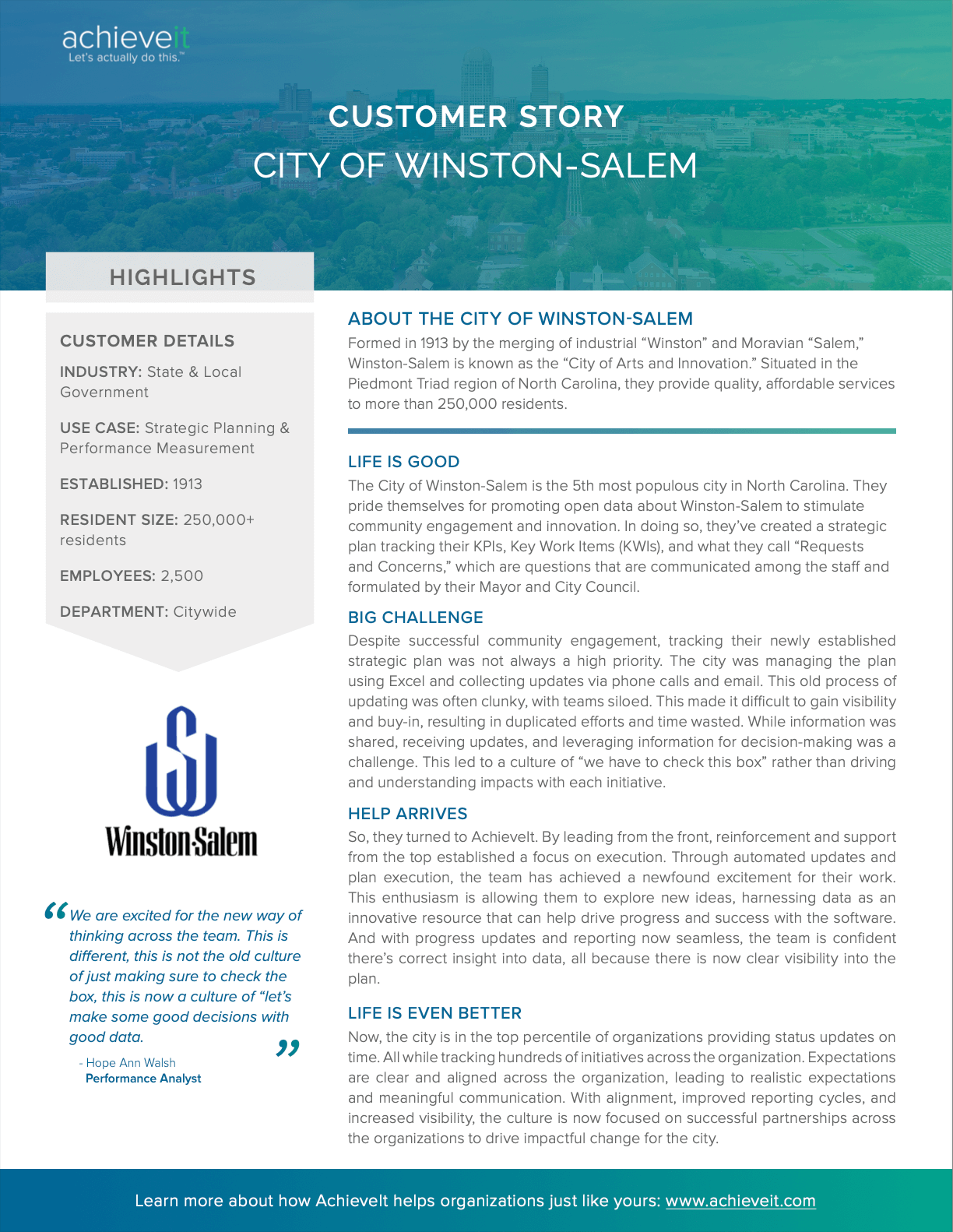A few months into implementing their carefully crafted strategy, a team gathers for an organization-wide meeting to present updates on their respective initiatives. Each department takes the floor, excitedly sharing their progress and achievements.
However, as the updates unfold, a glaring inconsistency emerges. Each presentation looks and feels different, with varying levels of detail, formatting, and content. Some focus on contextual updates, while others emphasize metric-driven results. The sheer disparity in reporting styles and information makes it difficult for the strategy leader to compile a cohesive picture of the organization’s progress, which hinders their ability to make informed decisions.
“The problem that a lot of organizations face is that every person’s or every department’s or every team’s updates look and feel different… It just makes it really hard to make a decision because nothing aligns up,” says Jonathan Morgan, AchieveIt’s VP of revenue operations and head of marketing.
By adopting a standard reporting process, organizations can eliminate the confusion and frustration caused by disparate reporting styles, enabling the strategy leader to gain a comprehensive view of the organization’s progress.
The significance of standardization in reporting
Creating a standard reporting process from the outset is a critical step in strategic planning and execution. It ensures that every department within an organization is reporting on the same key performance indicators (KPIs) and initiatives.
By implementing a standardized approach to reporting, organizations can reap several important benefits.
First and foremost, it creates uniformity across the board. This means that reports and dashboards present information in a consistent format, making it easier to understand and compare data across departments and how each is contributing to the overall strategic goals.
By adopting a standardized reporting process, organizations can move away from reporting-as-a-sales-pitch or a way to merely present positive outcomes. Instead, the focus shifts to analyzing data and updates objectively, which leads to understanding the true results and making data-driven decisions based on accurate and reliable information.
Moreover, it fosters transparency and accountability. When everyone follows the same reporting guidelines, it becomes easier to identify areas of success and areas that require attention or improvement. This enables leaders to assess performance consistently, compare results, and take appropriate action.
With a standardized approach to reporting, organizations also benefit from improved communication and collaboration. Clear and consistent reporting processes facilitate the effective sharing of information, enabling better alignment between departments and teams. They enhance cross-functional understanding and create a shared language, making it easier to collaborate and support one another in achieving strategic objectives.
By adopting a standardized approach, organizations can unlock the true potential of their data, gain actionable insights, expedite the process of collecting updates, and make informed decisions to drive strategic success.
FREE RESOURCE
The ROI of Efficient Execution
Download this guide and the companion calculator worksheet to show your team what you’re leaving on the table without enabling plan visibility, organizational alignment, or automated accountability.

How to establish a standard reporting process
To achieve consistency and clarity in reporting, organizations must embark on a deliberate process to establish a standard reporting process. This entails essential steps that lay the groundwork for effective and unified reporting practices. From establishing a shared language to implementing reporting tools and ensuring transparency, each stage plays a vital role in creating a cohesive reporting framework.
Step 1: Establish a common language
According to Jonathan, having a clear and consistent understanding of terminology is a crucial first step for effective strategic planning and execution. When different departments or individuals use varying terms to describe the same concepts, it creates confusion and makes it challenging to align goals and objectives across the organization. By establishing a common language, organizations can enable clear communication and understanding.
This common language extends beyond the planning phase — it also applies to status reporting. Jonathan highlights the need for consistent interpretation of status updates, saying, “Everybody has different levels of optimism when it comes to providing updates. For some people, everything’s on track. For others, nothing’s on track. The statuses used need to be defined objectively and not be open to interpretation.” By defining what each status represents and providing context behind the updates, organizations can eliminate ambiguity and foster a shared understanding of progress and challenges.
When organizations establish a common language, they create a foundation for effective communication, collaboration, and decision-making. It allows teams to align their efforts seamlessly, understand their collective goals, and work toward them in a cohesive manner. By ensuring that everyone is on the same page with shared terminology, organizations can streamline reporting processes and facilitate a more accurate and meaningful exchange of information.
Step 2: Plan the optimization process
During this process, organizations refine their strategic plans to make them more actionable, measurable, and aligned with their objectives. The plan optimization process encompasses several key elements that enhance the execution and reporting processes.
Determining KPIs and metrics: Organizations identify the key performance indicators (KPIs) and metrics that will accurately measure progress toward their goals. Defining these metrics provides clarity on what success looks like and how to track it effectively.
Implementing data validation and quality-control measures: Data validation and quality control are emphasized to ensure the accuracy and reliability of the reported information. By implementing measures such as data validation checks and review processes, organizations can minimize errors and inconsistencies in their reporting, leading to more reliable insights and decision-making.
Establishing clear roles and responsibilities: Assigning clear roles and responsibilities is essential for accountability and effective reporting. Organizations define and communicate roles to ensure that each person or team understands their responsibilities in providing accurate updates. This clarity reduces confusion and streamlines the reporting process.
The plan-optimization process enhances the effectiveness and efficiency of reporting, resulting in clearer insights, improved decision-making, and a more unified understanding of progress across the organization. It lays the foundation for accurate, consistent, and impactful reporting practices in the pursuit of strategic objectives.
Step 3: Implement reporting tools and technologies
To achieve a standardized reporting process, organizations can leverage reporting tools like AchieveIt that offer several key advantages in terms of visibility, accountability, and standardization.
With reporting tools, organizations gain enhanced visibility into their reporting processes. These tools provide centralized platforms that store all updates and data, allowing for easy access and review across teams and departments. This eliminates the need for manual data gathering and enables the real-time tracking of progress.
Reporting tools also ensure greater accountability by automating prompts and notifications for timely updates. Individuals responsible for providing updates are prompted within predefined timeframes, reducing the need for constant follow-ups and reminders. This streamlines the reporting process and ensures adherence to reporting timelines.
Furthermore, reporting tools facilitate standardization by offering predefined templates and structures. These tools enable organizations to establish uniform reporting formats and guidelines, eliminating variations and facilitating easier analysis and data comparison.
Step 4: Ensure transparency and accessibility for external stakeholders
Organizations working in certain sectors must ensure the transparency and accessibility of their strategic reporting to external stakeholders. A common example is government entities that need to present information to their constituents. By implementing a standardized reporting process, organizations can provide consistent and easily understandable updates to external audiences.
AchieveIt enables organizations to share information on public platforms, ensuring that citizens and stakeholders can access and review performance data in a unified format. This transparency builds trust, enhances communication, and demonstrates the organization’s commitment to open and accountable reporting practices.
FREE RESOURCE
City of Winston-Salem Customer Story
Read this customer story to better understand how a local government agency gained insight into their strategic plan and created an organized, real-time status repository with AchieveIt.

How AchieveIt helped the City of Winston-Salem transform its strategic updates process
For the City of Winston-Salem, AchieveIt played a crucial role in overcoming the challenges it faced in managing its strategic plan. The city had been relying on Excel spreadsheets and manual updates through phone calls and emails. This process led to inefficiencies and siloed teams, as well as a lack of visibility and buy-in. As a result, efforts were duplicated, and valuable time was wasted. AchieveIt provided the solution it needed to streamline its processes, gain better visibility, and foster collaboration across the organization.
By leveraging automated updates and plan execution, the City of Winston-Salem experienced a renewed sense of enthusiasm and focus on execution. The software empowered it to explore new ideas and use data as an innovative resource to drive progress and success. With seamless progress updates and reporting, the city now has clear visibility into its plan, resulting in improved decision-making and impactful change.
Today, the City of Winston-Salem has a strong commitment to alignment, improved reporting cycles, and increased visibility. All of this has fostered a culture of successful partnerships and meaningful communication. To learn more about the City of Winston-Salem’s journey with AchieveIt, we invite you to explore the full case study.



